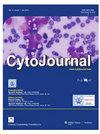Analyzing histopathological aspects and cell populations in orbital inflammatory involvement in systemic diseases: A case series from the Rheumatologist’s perspective
IF 2.5
4区 医学
Q2 PATHOLOGY
引用次数: 0
Abstract
Orbital inflammatory disease (OID) comprises approximately 6% of orbital conditions, affecting individuals across all ages. The range of the primary orbital inflammation’s differential diagnosis is extensive, encompassing autoimmune disorders such as thyroid diseases, vasculitis, sarcoidosis, connective tissue diseases, immunoglobulin G4-related disease (IgG4-RD), and giant cell myositis, whereas secondary causes span from infections to drug-induced causes. Analyzing histopathological aspects and cell populations could enhance our comprehension of the etiology of orbital inflammatory involvement in systemic diseases such as IgG4-RD. We present a series of four patients from our Rheumatology clinic, each with distinct systemic diseases, illustrating diverse manifestations of OID. This series was conducted to facilitate discussions and diagnoses of challenging cases of OID in a rheumatologic setting. The difficulty in the differential diagnosis arises from the extensive range of structures involved, resulting in a significant variation of clinical manifestations. Furthermore, the lack of definitive diagnostic laboratory tests and, often, histological findings add to the complexity. OID poses diagnostic challenges with variable clinical manifestations and overlapping imaging findings. As a diagnosis of exclusion, a comprehensive evaluation is crucial, often necessitating an orbital biopsy for confirmation. Collaborative efforts among specialists are essential for managing these intricate cases.分析全身性疾病眼眶炎症受累的组织病理学方面和细胞群:从风湿免疫科医生的角度看系列病例
眼眶炎症性疾病(OID)约占眼眶疾病的 6%,影响着各个年龄段的人。原发性眼眶炎症的鉴别诊断范围很广,包括甲状腺疾病、血管炎、肉样瘤病、结缔组织病、免疫球蛋白 G4 相关疾病(IgG4-RD)和巨细胞肌炎等自身免疫性疾病,而继发性眼眶炎症的病因则从感染到药物诱发不等。对组织病理学方面和细胞群进行分析有助于我们更好地理解眼眶炎症受累于 IgG4-RD 等全身性疾病的病因。我们介绍了风湿病门诊的四例患者,每例患者都患有不同的系统性疾病,说明了眼眶炎的不同表现。该系列研究旨在促进风湿病学领域对具有挑战性的 OID 病例的讨论和诊断。鉴别诊断的困难在于涉及的结构范围很广,导致临床表现差异很大。此外,由于缺乏明确诊断的实验室检查和组织学检查结果,这也增加了诊断的复杂性。OID 的临床表现多变,影像学检查结果重叠,给诊断带来了挑战。作为一种排除性诊断,全面的评估至关重要,通常需要进行眼眶活检来确诊。专科医生之间的合作对于处理这些复杂病例至关重要。
本文章由计算机程序翻译,如有差异,请以英文原文为准。
求助全文
约1分钟内获得全文
求助全文
来源期刊

Cytojournal
PATHOLOGY-
CiteScore
2.20
自引率
42.10%
发文量
56
审稿时长
>12 weeks
期刊介绍:
The CytoJournal is an open-access peer-reviewed journal committed to publishing high-quality articles in the field of Diagnostic Cytopathology including Molecular aspects. The journal is owned by the Cytopathology Foundation and published by the Scientific Scholar.
 求助内容:
求助内容: 应助结果提醒方式:
应助结果提醒方式:


